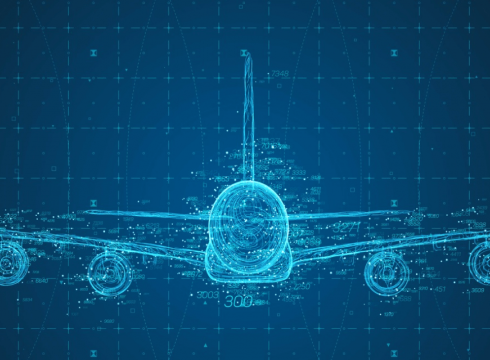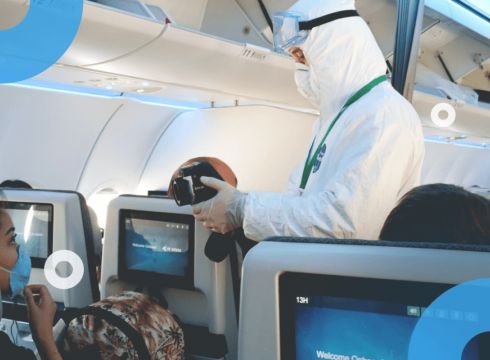Airline Industry: What Will Be The New Learnings From This Outbreak?

With the numbers of passengers dropping sharply, airports at risk of closure and thousands of job losses, it’s difficult to see any potential positive outcomes of the COVID-19 crisis.
The airline trade group, International Air Transport Association, has already predicted that revenues will fall by more than half as a result of the crisis and that it’ll be years before air travel returns to 2019 levels. So, with no end to the global crisis in sight, the outlook may not seem bright for the airline industry.
However, previous crises such as the SARS epidemic and events such as 9/11 prompted the development of innovative ways to ensure that passengers could quickly begin travelling safely again. This led to a reduced revenue impact on the industry and opportunities for entrepreneurs who were offering new products and services.
Being prepared for these changes and knowing the potential areas of opportunity will help members of the airline industry survive and bounce back as quickly as possible from the impacts of the coronavirus crisis.
Potential Impacts of COVID-19
Industry commentators and advisors have already speculated that the COVID-19 crisis will have an impact unmatched by anything airline has dealt with before. Still ongoing, it’s difficult to predict what the scope of these outcomes will be. However, looking at historical global health outbreaks, such as Ebola and SARS, may help the industry to predict any positive or negative results of the coronavirus.
Similarly to the coronavirus crisis, the SARS outbreak of 2003 spread quickly from Southeast Asia to the rest of the world. Measures were quickly put in place by airlines to reduce the impact of the virus, including:
- New procedures and training for airport staff, cabin crew and maintenance teams, as well as the provision of PPE(Personal Protective Equipment)
- Surveillance and screening of passengers at airport departure and arrival points and during flights
- Introduction of disinfecting procedures for aircraft
Due to the similarities between SARS and COVID-19, it’s likely that similar procedures and controls will need to be put in place by airports and operators to protect passengers. However, unlike with SARS, which caused a nine-month hiatus in air travel, this outbreak is likely to continue for the long-term, meaning that new methods will have to be found to protect passengers and crew so that the airline industry can recover effectively.
Adapting to the Coronavirus Outbreak
Airline experts have suggested that new technologies will play a large part in the recovery of the industry, and some have already started to be considered to help operators deal with the crisis.
One such technology may include GermFalcon, which was developed after the Ebola virus outbreak in 2014 in partnership with Virgin America (now part of Alaska Airlines). It’s been reported that the device, which kills germs in airplane cabins using ultraviolet light, is being reviewed as a potential disinfectant tool by airlines in the USA.
Harnessing security and operations technologies to ensure smooth and safe passenger journeys is also an important consideration for operators, says Heathrow Airport Health and Safety Director Amanda Owen in her interview with a travel news website.
“Prior to COVID-19, Heathrow had already begun investing in a next-generation security programme,” she said. “This programme looks at how we can use technology to streamline the security search process, further reducing the need for person-to-person contact. This is more important now than ever, so that passengers can travel with confidence once we look to restart the economy.”
These security and health screening procedures and technologies are just one area where the industry is already looking to adapt and where new opportunities will open up for entrepreneurs and technology companies.
New Protective Precautions and Procedures
Putting measures in place to protect both passengers and crew will be essential to ensure that airlines can operate in the long term. As well as providing PPE for staff and putting procedures and screening technologies in place to protect travellers, events such as 9/11 have shown that adapting to moving circumstances and keeping the public informed of these changes in a clear and efficient way is essential for airline operation to be successful.
This involves developing a system whereby the danger to passengers and crew can be regularly assessed and appropriate controls put in place quickly and easily. In Singapore, which has one of the lowest death rates in the world, the Disease Outbreak Response System Condition was developed to help educate the public during the 2003 SARS outbreak, 2009 H1N1 pandemic and is now being used to track COVID-19.
Aligning operations to such a model when one is available, or creating a new system, will help controls to be applied appropriately and passengers to understand why they are being put in place and give them reassurance, even during shifting circumstances.
Changes in In-flight and Terminal Regulations and Operations
As well as using new screening procedures and technologies to protect health, adapting regulations and operations will help the industry to cope with the long-term effects of the outbreak. These changes will influence everything from the way terminal check-ins are laid out to help passengers and crew maintain a two-metre distance, to how essential cargos are processed safely and efficiently to ensure that airports can provide effective support during the crisis.
One of the main learnings for operators though is to ensure that there is always a plan in place to adapt regulations and operations to circumstantial changes quickly and effectively, says Stephanie Murphy, Assistant Vice President of Preparedness, Resiliency and Emergency Management for Tidal Basin.
“To better prepare the workforce, business continuity or continuity of operations, plans should be developed, trained on and exercised,” she says. “Airports should also work through multiple courses of action or planning assumptions so as to have multiple options to choose from when confronted with the emergency.”
Increase in the Use of Digital Tools and Data
To reduce the need for contact between passengers and crew, and therefore reduce the risk of passing on the coronavirus, data and digital tools have the potential to become more useful and prevalent.
Potential technologies and data points that could be used include:
- Using biometrics and other touchless technologies for check-in and security processing, such as contactless fingerprints, iris and face recognition.
- Digital health passports which will reduce the need to carry out physical screenings in airports by sharing passenger information such as age, underlying health conditions and travel history to help operators compile a risk profile before they travel.
- Shared databases and initiatives such as the Known Traveller Digital Identity that aims to help airline operators verify passengers’ identities and enable a smoother, safer travel process.
Questions around data sharing and safety will all impact on the speed at which these technologies are developed and deployed, but this is one of the major areas where new learnings will be used and changes made.
Creating a Safe and Smooth Passenger Experience
Reassuring passengers that it is safe to travel will be the main task of the airline industry as people start to consider flying again. By using tools that create a smooth, safe experience for passengers from the moment they buy their ticket to when they board the plane, will help to reassure travellers and encourage them to fly more often.
The importance of effective digital tools to reassure passengers has become clear during the crisis, which is why it’s essential that operators focus on making their digital customer-facing processes as smooth and easy to use as possible to ensure their passengers are reassured. This won’t just help to encourage travellers to use operators more effectively, but to share their data or make ancillary purchases.
By harnessing digital tools more effectively and starting to think in a more agile, adaptive way about procedures and operations, the airline industry can take the learnings from COVID-19 and use them to recover as quickly and effectively as possible.




